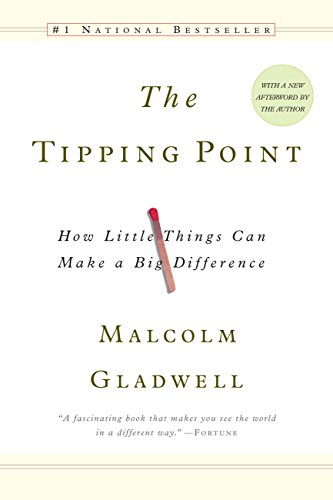

This article is an excerpt from the Shortform summary of "The Tipping Point" by Malcolm Gladwell. Shortform has the world's best summaries of books you should be reading.
Like this article? Sign up for a free trial here .
How does our environmental context, the changes in our setting, affect our behavior? Can subtle changes in our environments determine whether or not an idea or product catches on?
We’ll cover the science behind how your environmental context affects your behavior and look at a surprising example of the ways subtle changes in our environmental context and affect you.
The Power of Your Environmental Context
Whereas the first two principles of epidemics address the people who help spread the message far and wide (The Law of the Few) and how effectively an idea or message can take hold (The Stickiness Factor), the third principle has to do with the conditions that lend themselves to an epidemic catching on. According to the Power of Environmental Context, people are so sensitive to conditions and changes in our environment that context can determine whether or not an epidemic tips.
In the case of Paul Revere, the fact that he made his ride in the middle of the night was pivotal in helping the word-of-mouth epidemic catch on. First, it was easier to reach people knowing they were all at home in bed — rather than scattered around at work or running errands. Second, people understood that if Revere’s message was urgent enough that he had to wake them in the middle of the night, it must be important.
Subtle, seemingly insignificant changes in our immediate environments can make us more likely to change our behavior; when done on a broad enough scale, this can ignite an epidemic. These changes may be in our physical environmental context.
Case Study: Environmental Context Reducing Crime in NYC
Let’s see how much environmental context affects crime rates. During the 1980s, New York City had some of the highest crime rates in its history. Suddenly, in the 1990s, crime rates plummeted faster and more dramatically than any other city during that same period.
This drop appeared to be an anti-crime epidemic in how quickly and widely it took hold, but it didn’t really follow the first two principles of epidemics — The Law of the Few and The Stickiness Factor.
- First, it’s not as if Connectors, Mavens, or Salesmen were broadcasting a message across New York City that now is the time to run amok with crime, or now is the time to collectively stop.
- Second, crime is not one specific idea, product, or message. Crime is a collective term for a wide range of actions and behaviors, which each have their own complex set of contributing factors (e.g. the reasons for a rise or fall in home burglaries can be completely different than the reasons for a change in the murder rate). It’s hard, if not impossible, to pinpoint a stickiness factor for such a range of actions and behaviors.
NYC’s anti-crime epidemic relied strongly on the third principle, The Power of Environmental Context. The change in environmental context had to do with a policing approach called the Broken Windows Theory, which says that smaller signs of disorder — like broken windows left in disrepair on a building — send the message that anything goes. This subtle message leads to greater crime and public disorder. In other words, the environmental context is spreading a message that changes people’s behavior and leads to an epidemic.
Initially, NYC police’s Broken Windows approach led them to tackle graffiti in the subway systems. They made enormous efforts to keep trains clean of graffiti in order to send the message that someone was paying attention and even small infractions would not be overlooked.
Then, transit police cracked down on fare-beating, when people would hop subway turnstiles or find other ways to get onto the trains without paying the fares. Again, if one person skipped paying the fare, it signaled to other passengers that they shouldn’t have to either. That mentality easily snowballs into defiance against other, more serious rules as well.
The transit police had to take a gamble on putting so much effort and resources on fare-beating — which, in isolation, is a small offense — at a time when more serious crimes on the subway were at an all-time high. It can be challenging to put the Power of Environmental Context to practice because making small contextual changes to create a big impact feels counterintuitive. But if you make the right changes, you’ll see the results.
After seeing results from their strategy in the subway system, NYPD implemented the Broken Windows approach across the city. Officers targeted minor crimes including public drunkenness, public urination, throwing empty bottles on the street, and minor property damage. Ultimately, violent crimes dropped in the subway system and across the city, and NYPD administrators believed the Broken Windows approach deserves the credit.
The mayor and police chief reasoned that enforcing minor infractions sent the message that no criminal activity — even seemingly insignificant offenses — would be tolerated. That message spread and altered would-be criminals’ behavior, reversing the crime epidemic, or alternatively creating an anti-crime epidemic. This exemplifies the Power of Environmental Context, illustrating how small environmental changes can tip an epidemic.
———End of Preview———

Like what you just read? Read the rest of the world's best summary of "The Tipping Point" at Shortform . Learn the book's critical concepts in 20 minutes or less .
Here's what you'll find in our full Tipping Point summary :
- What makes some movements tip into social epidemics
- The 3 key types of people you need on your side
- How to cause tipping points in business and life







I believe that serious environment changes often happen first in the distant horizon as weak signals happening far away and are not easily detectable. These weak disturbances in life are just the early beginnings of what may turn out to be a destructive torrential storm. A smart and observant watcher will very quickly detect this and quickly get equipped and prepared for the eventual storm. So then, how can one catch the “tipping point” , and get prepared for the “big storm”? What do you think ?